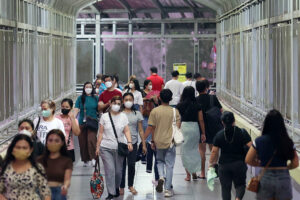




Monthly Economic Update: One for the road
 DOWNLOAD
DOWNLOAD

Inflation Update: Still low, still slow
 DOWNLOAD
DOWNLOAD

Philippines Trade Update: Exports momentum continues
 DOWNLOAD
DOWNLOAD


OECD sees PH growth at 5.7%

THE ORGANISATION for Economic Co-operation and Development (OECD) expects the Philippine economy to expand by 5.7% this year, slightly below the government’s target.
“Exports may slow in 2023 due to the global economic slowdown, and tighter monetary conditions to cope with high inflationary pressures may pose a challenge for private consumption and investment growth,” the OECD said in its Economic Outlook for Southeast Asia, China, and India report.
The OECD’s gross domestic product (GDP) growth forecast for the Philippines is below the government’s 6-7% target this year. It is also slower than the 7.6% GDP expansion in 2022.
Based on the OECD projections, the Philippines has the second-highest GDP forecast among Association of Southeast Asian Nations (ASEAN) member-countries, behind only Vietnam’s 6.4%.
The Philippines is expected to grow faster than Cambodia (5.4%), Indonesia (4.7%), Malaysia (4%), Thailand (3.8%), Laos (3.5%), Brunei (3.2%), Singapore (2.2%), and Myanmar (2%).
For 2024, the OECD gave a 6.1% GDP growth forecast for the Philippines, which is also below the government’s 6.5-8% target.
“This is especially impressive given the grim outlook for the global economy and the backdrop of rising inflation and interest rates in the second half of 2022,” the OECD said.
Resilient household spending, investments, and continued growth in services and exports are seen to drive the Philippine economy’s expansion, it added.
“However, export growth is expected to perform relatively poorly in 2023 by historical standards given the slowing global economic growth, although an increase in economic activity in China following its reopening of its borders will be beneficial. Weaker domestic demand will reduce import growth in 2023,” it added.
Inflation and high interest rates will continue to hurt economic growth.
“Tighter monetary conditions will weigh on private consumption and investment growth. The Philippine peso is facing depreciation pressures, weighed down by inflationary pressures and an abnormally large interest rate differential with the United States that is driving severe capital outflows,” the OECD said.
Inflation averaged 8.3% in the first quarter, well above the central bank’s 6% full-year forecast.
To curb inflation, the BSP has increased its benchmark rate by 425 basis points (bps) since May 2022 to 6.25% — the highest in nearly 16 years.
Meanwhile, the OECD projected ASEAN’s average GDP growth will reach 4.6% this year and 4.8% in 2024.
Emerging Asia — which refers to ASEAN plus China and India — is seen expanding by 5.3% in 2023 and 5.4% in 2024.
However, the region must continue to address external headwinds to continue to support growth.
“Emerging Asian economies still face risks that could negatively affect their growth and stability, such as inflation, the global economic slowdown and supply chain disruptions,” the OECD said.
It described the current inflationary episode in the region as “very long and persistent” and while not “particularly high,” it is still showing signals of continued acceleration.
“They face persistent inflationary pressures, including higher food and energy prices. The combination of inflationary pressures and increasing interest rates in advanced economies have put pressure on capital flows and local currencies in the region,” it added.
Tourism
The OECD also emphasized the need to prioritize the recovery of the tourism sector to boost growth in the region.
Data showed that travel and tourism contributed 11.7% of GDP and 13.2% of employment in Southeast Asia in 2019 or before the pandemic.
The Philippine Statistics Authority The tourism sector contributed 12.7% to Philippine GDP in 2019, based on data from the local statistics authority. This shrank to 5.2% of GDP in 2021, reflecting the impact of the pandemic.
The OECD said the Philippines should focus on environmental protection and enforcement to protect its top destinations.
“The Philippines also offers a favorable business environment for tourism development, and entrepreneurs should be given clear opportunities to take advantage of it. Human capital development, including language training, will be helpful,” it added.
To mitigate risks, the tourism sector in emerging Asia should “adapt to the various challenges such as diversifying inbound markets, promoting domestic tourism and stabilizing the labor market.”
The OECD said the region can diversify sources of inbound tourism by maximizing intra-ASEAN travel and looking into untapped markets.
“Diversification of international inbound markets is recommended for some countries in the region, such as the Philippines, Vietnam, Myanmar, Cambodia and Lao PDR. Strengthening intra-ASEAN travel is recommended particularly for the Philippines and Vietnam, where there is relatively little regional traffic,” it added.
In 2019, visitors from ASEAN to the Philippines only accounted for 6% of total inbounds.
The Philippines should increase air connections to major ASEAN cities and tailor marketing efforts to attract more travelers from ASEAN, the OECD said.
“Even though cross-border travel restrictions are gone, the demand for local travel and rediscovery is growing. Domestic tourism should thus remain a priority, with the added benefits that it reduces both dependency on international arrivals and the sector’s carbon footprint,” it added,
Domestic spending comprises at least 50% of all tourism spending in Indonesia, Malaysia, Brunei, India, the Philippines, and China.
“With strong domestic tourism, Indonesia and the Philippines might pursue a product development strategy targeting domestic tourists by providing new products, experiences and services,” it added.
Equipping tourism workers with relevant skills such as languages and hospitality management, is also a priority, the OECD said.
The tourism sector must also shift to more sustainable practices.
“Visitor management strategies can help address overtourism, which damages sites and local environments, and disrupts the lives of residents. Offering alternative niche forms, such as ecotourism, can also help promote more sustainable practices and diversify the sector,” the OECD said. — By Luisa Maria Jacinta C. Jocson
This article originally appeared on bworldonline.com





 By BusinessWorld
By BusinessWorld